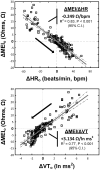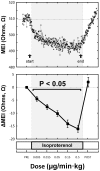Myocardial electrotonic response to submaximal exercise in dogs with healed myocardial infarctions: evidence for β-adrenoceptor mediated enhanced coupling during exercise testing
- PMID: 25698976
- PMCID: PMC4318283
- DOI: 10.3389/fphys.2015.00025
Myocardial electrotonic response to submaximal exercise in dogs with healed myocardial infarctions: evidence for β-adrenoceptor mediated enhanced coupling during exercise testing
Abstract
Introduction: Autonomic neural activation during cardiac stress testing is an established risk-stratification tool in post-myocardial infarction (MI) patients. However, autonomic activation can also modulate myocardial electrotonic coupling, a known factor to contribute to the genesis of arrhythmias. The present study tested the hypothesis that exercise-induced autonomic neural activation modulates electrotonic coupling (as measured by myocardial electrical impedance, MEI) in post-MI animals shown to be susceptible or resistant to ventricular fibrillation (VF).
Methods: Dogs (n = 25) with healed MI instrumented for MEI measurements were trained to run on a treadmill and classified based on their susceptibility to VF (12 susceptible, 9 resistant). MEI and ECGs were recorded during 6-stage exercise tests (18 min/test; peak: 6.4 km/h @ 16%) performed under control conditions, and following complete β-adrenoceptor (β-AR) blockade (propranolol); MEI was also measured at rest during escalating β-AR stimulation (isoproterenol) or overdrive-pacing.
Results: Exercise progressively increased heart rate (HR) and reduced heart rate variability (HRV). In parallel, MEI decreased gradually (enhanced electrotonic coupling) with exercise; at peak exercise, MEI was reduced by 5.3 ± 0.4% (or -23 ± 1.8Ω, P < 0.001). Notably, exercise-mediated electrotonic changes were linearly predicted by the degree of autonomic activation, as indicated by changes in either HR or in HRV (P < 0.001). Indeed, β-AR blockade attenuated the MEI response to exercise while direct β-AR stimulation (at rest) triggered MEI decreases comparable to those observed during exercise; ventricular pacing had no significant effects on MEI. Finally, animals prone to VF had a significantly larger MEI response to exercise.
Conclusions: These data suggest that β-AR activation during exercise can acutely enhance electrotonic coupling in the myocardium, particularly in dogs susceptible to ischemia-induced VF.
Keywords: arrhythmic risk; electrotonic coupling; exercise; myocardial infarction; β-adrenoceptor stimulation.
Figures







Similar articles
-
Electrotonic remodeling following myocardial infarction in dogs susceptible and resistant to sudden cardiac death.J Appl Physiol (1985). 2008 Feb;104(2):386-93. doi: 10.1152/japplphysiol.01106.2007. Epub 2007 Nov 29. J Appl Physiol (1985). 2008. PMID: 18048585
-
Effects of acute vagal nerve stimulation on the early passive electrical changes induced by myocardial ischaemia in dogs: heart rate-mediated attenuation.Exp Physiol. 2008 Aug;93(8):931-44. doi: 10.1113/expphysiol.2007.041558. Epub 2008 Mar 30. Exp Physiol. 2008. PMID: 18376003
-
Endurance exercise training attenuates cardiac beta2-adrenoceptor responsiveness and prevents ventricular fibrillation in animals susceptible to sudden death.Am J Physiol Heart Circ Physiol. 2006 Jun;290(6):H2590-9. doi: 10.1152/ajpheart.01220.2005. Epub 2005 Dec 30. Am J Physiol Heart Circ Physiol. 2006. PMID: 16387787
-
A comprehensive review and analysis of 25 years of data from an in vivo canine model of sudden cardiac death: implications for future anti-arrhythmic drug development.Pharmacol Ther. 2006 Sep;111(3):808-35. doi: 10.1016/j.pharmthera.2006.01.002. Epub 2006 Feb 17. Pharmacol Ther. 2006. PMID: 16483666 Review.
-
Autonomic control of heart rate: pharmacological and nonpharmacological modulation.Basic Res Cardiol. 1998;93 Suppl 1:133-42. doi: 10.1007/s003950050239. Basic Res Cardiol. 1998. PMID: 9833141 Review.
Cited by
-
Influence of Exercise Mode on Post-exercise Arterial Stiffness and Pressure Wave Measures in Healthy Adult Males.Front Physiol. 2018 Oct 17;9:1468. doi: 10.3389/fphys.2018.01468. eCollection 2018. Front Physiol. 2018. PMID: 30459633 Free PMC article.
-
Editorial: Cardiac electronic remodeling and susceptibility to arrhythmias: an introduction and brief historical overview.Front Physiol. 2015 Jul 6;6:196. doi: 10.3389/fphys.2015.00196. eCollection 2015. Front Physiol. 2015. PMID: 26217235 Free PMC article. No abstract available.
-
Antiarrhythmic Effects of Melatonin and Omega-3 Are Linked with Protection of Myocardial Cx43 Topology and Suppression of Fibrosis in Catecholamine Stressed Normotensive and Hypertensive Rats.Antioxidants (Basel). 2020 Jun 22;9(6):546. doi: 10.3390/antiox9060546. Antioxidants (Basel). 2020. PMID: 32580481 Free PMC article.
-
Heart Rate Changes Before, During, and After Treadmill Walking Exercise in Normal Dogs.Front Vet Sci. 2021 Apr 12;8:641871. doi: 10.3389/fvets.2021.641871. eCollection 2021. Front Vet Sci. 2021. PMID: 33912604 Free PMC article.
References
-
- Avendano C. E., Billman G. E. (1994). Effect of interventions that increase cyclic AMP levels on susceptibility to ventricular fibrillation in unanesthetized dogs. Eur. J. Pharmacol. 255, 99–109. - PubMed
-
- Barnes G. E., Horwitz L. D., Bishop V. S. (1979). Reliability of the maximum derivatives of left ventricular pressure and internal diameter as indices of the inotropic state of the depressed myocardium. Cardiovasc. Res. 13, 652–662. - PubMed
Grants and funding
LinkOut - more resources
Full Text Sources
Other Literature Sources
Research Materials

